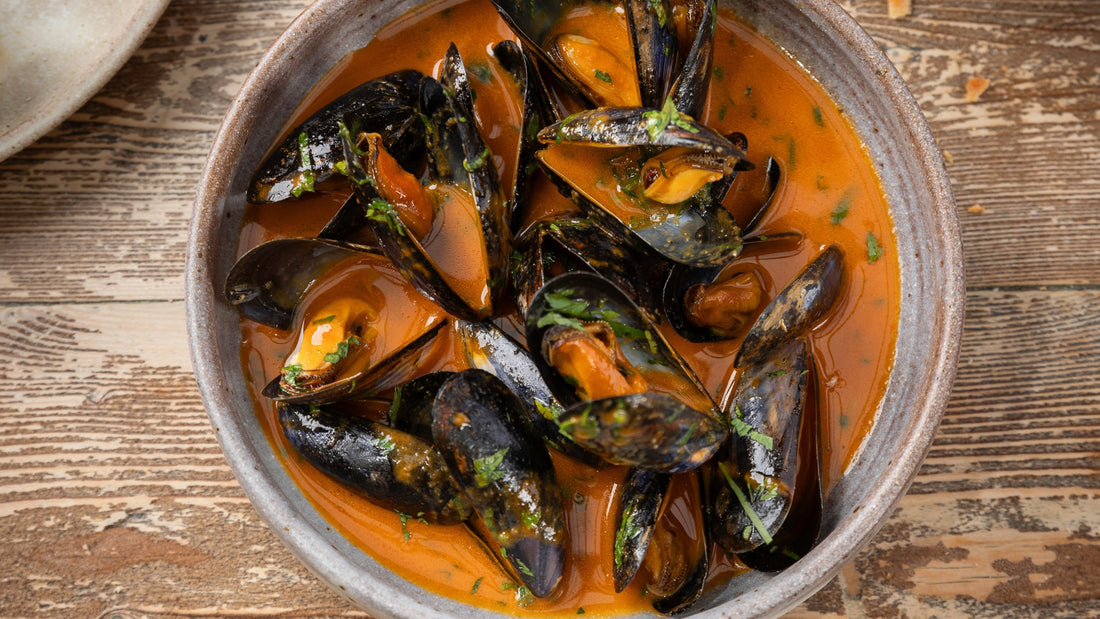Serves 4 as a main course or 8 as a starter
We used to serve this as a Dublin Bay prawn pil pil, but the price of the Irish prawns rocketed so we switched to Irish mussels – a controversial move if there ever was one. Complaints were received in the strongest possible terms from regulars including Denise’s sister Emma to actor Domhnall Gleeson when he turned up to dine in our front bar with some mate of his called Michael Fassbender. But there’s a Team Mussels too. Many regulars agree with sous chef Naiara Passos, who says it ‘combines the sweet and briny flavours of the mussel with a delicious, rich sauce with the perfect kick’. The debate rages on. Experiment at home and let us know which side you’re on.
2kg mussels (we use Roaring Water Bay)
250ml white wine
FOR THE PIL PIL SAUCE:
2 tablespoons neutral oil
100g garlic cloves (1–2 whole bulbs), separated, bashed and peeled
80g (about 3–4) fresh red chillies, roughly sliced
50ml white wine
280ml cream
70ml red wine jus (optional; see the recipe below)
sea salt and freshly ground black pepper
TO SERVE:
a small handful of fresh parsley leaves, chopped
1 large crusty baguette
Wash the mussels in a colander in the sink, removing and discarding the stringy beards by pulling out and up towards the top of the shell. You can also chip off any barnacles for a cleaner presentation. Discard any mussels that are damaged or that remain open after handling. Gently tap them on the counter to check – if they don’t close, discard them.
To make the sauce, heat 1 tablespoon of the oil in a heavy-based saucepan over a medium-high heat. Add the garlic and chillies and cook for a few minutes, until the chillies start to soften. Transfer to a blender and pulse once or twice, add another tablespoon of oil and blitz until smooth.
Scrape the paste back into the pan over a medium-high heat and cook for a few minutes, until the garlic smells sweet rather than pungent. Add the wine and continue to cook for another few minutes at a rolling simmer to reduce by half. Add the cream and the red wine jus (if using) and reduce by at least half to bring it to a sauce consistency. Season to taste and pass through a fine mesh sieve. You can refrigerate this sauce for up to three days before using but be sure to cover it well by placing a layer of cling film or a parchment cartouche directly on the surface to prevent a skin from forming.
Meanwhile, heat another large heavy-based saucepan over a high heat until it’s smoking hot. Add the mussels and the wine, cover and cook for 3–4 minutes, until all the mussels open. Discard any that are closed.
Strain the mussels of their cooking stock. Stir 70ml of the mussel stock into the strained pil pil sauce, then discard the rest.
Pour the mussels back into the pan, then pour over the pil pil sauce and return the pan to a brisk heat for a couple of minutes to heat through.
To serve, divide the mussels and sauce among warm serving bowls. Garnish with chopped parsley and serve with plenty of crusty baguette. Don’t forget to provide an empty bowl for mussel shells within easy reach and individual fingers bowls with warm water, a slice of lemon and a clean, crisp napkin.
Red wine jus
Makes about 600ml
Just a little red wine jus adds richness and depth of flavour to all sorts of dishes, from mussels pil pil to a Sunday roast gravy, so consider freezing it into ice cubes for ease of use.
20g salted butter
1 tablespoon neutral oil
2 shallots, quartered
2 carrots, roughly chopped
1 celery stick, roughly chopped
1 garlic clove, roughly chopped
1 bay leaf
a few sprigs of fresh thyme
a small handful of fresh parsley
20g tomato purée
500ml red wine
1 tablespoon caster sugar
1 tablespoon balsamic vinegar
2 litres beef stock
Heat the butter and oil in a heavy-based saucepan over a medium heat. Add the vegetables, garlic and herbs and cook for about 5 minutes, until the veg develop a nice golden brown colour.
Stir in the tomato purée and cook for a minute or two. Add the wine, sugar and balsamic, bring up to a simmer and reduce by half. Add the beef stock and reduce slowly for about 35 minutes, until it reaches a sauce consistency.
Pass through a fine mesh sieve and allow to cool. This will keep in the fridge for up to five days and freezes well for up to three months.

From The Old Spot Cookbook: A Decade at Dublin’s Favourite Gastropub

